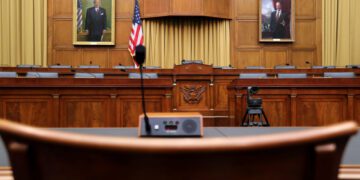There is an old saying: to a hammer, every problem looks like a nail. This is truly the only point of view from which the administrations recommended “solution” to current port congestion makes any sense.
Consider this: at the ports of Los Angeles and Long Beach, the largest containership ports in the United States, a massive influx of volume over the past year has caused perpetual congestion. With volumes consistently 30% to 40% above the norm over the past year or so, these ports simply cannot handle the volume.
It has now become common for 50 to 100 ships to be sitting at anchor at a time, out in the Los Angeles harbor and beyond, awaiting open berths.
In recent weeks, the Biden-Harris regime has directed the seaports of Los Angeles and Long Beach to immediately implement a draconian surcharge scheme: Any container not moved promptly, regardless of owner, contractor, or other controller, shall be saddled with a fee schedule starting at $100, compounded daily (ie. day one, $100, day two, $200, day three, $300, etc.), so that every shipment will cost its customer thousands of dollars more.
If industry interpretations of the preliminary announcements are correct, every single ocean container arriving in LA will be fined many thousands of dollars, potentially even tens of thousands of dollars, all to be passed on to importers and obviously, therefore, to consumers… for something completely out of their control in any way.
The problems with the scheme are infinite; let’s review just a few:
Shared Responsibility, Solitary Blame
Over the past few decades, the container ship lines have responded to growing volumes in international trade by building ever larger ships and ordering ever larger fleets of containers in which to move the cargo.
Throughout this period, the seaports, railroads, and railyards in particular, have not grown at anywhere near this rate. They have grown, but barely, by comparison.
As a result, the steamship lines that have been responsible in meeting the volume demanded by the market are being punished… while the ports and railroads most responsible for the congestion are being absolved of responsibility.
Is that fair or sensible?
The Cargo Movement Process
Ocean containers are intermodal. This means that they are designed to be transferred from truck to train to ship and back, with ease and speed.
Each container has designated grappling points, so that cranes can pick them up and set them down, on rail car, on truck chassis, or onboard ship… Or on top of other containers, in stacks at the port or railyard, until they’re ready for the next leg of their journey.
Since ports and railyards have not grown at the same rate as volume has demanded, they have become clogged with these stacks of containers, waiting for the system to catch up. The ships are on loaded onto the pier, and then the port has to wait for trucks and railroads to clear the containers out of there, so there can be room for the next ship to be worked.
The container on top of a stack can be moved quickly; the container on the bottom might sit for days or weeks. Nobody has a choice as to whether his container lands on the top or bottom of such a stack. It’s the luck of the draw.
And remember, in between two unloadings, there must be a loading as well. Half the pier is taken up with the stacks of containers ready for the next sailing. Once cargo is unloaded from a ship, a similar number of containers, both full and empty, must be loaded onto the ship before it can move out of its berth.
A few years ago, when the volume was not this extreme, there was time between ships for this cargo timing imbalance to even out. But today, with 100 ships lined up for the next berth to open up, there is no time to play catch-up between ships… the next ship pulls in, expecting to see an empty area in which to unload, and that area is still clogged, so there is no place to put their cargo.
And so the problem continues to grow.
The Equipment Imbalance
One reason for the above challenge is simply the different speeds at which different vehicles can move. Cranes can swing containers off ships very quickly… It takes longer for a truck or train to collect that container, have it properly fitted to a chassis or railcar, and move it out of the port complex on crowded roadways or rail spurs.
But an additional challenge is that there aren’t enough rail cars or chassis to match this volume. Even when you have a driver, even when you have a train, there must be a set of wheels on which to place that container. The system is short these wheels… There is a perpetual shortage of both railcars and chassis.
Steamship lines own many of the chassis in the network, but trucking companies, warehouses, distribution systems also own their own fleets of chassis. Because of this divided ownership of fleets of wheels, the shortage in chassis and railcars was not as easy to predict as the shortage in ground space; and it takes a long time to manufacture new chassis and railcars.
While containers to move by truck, obviously, move one-by-one, the railroads have a similar problem, only in bunches of dozens or hundreds; they don’t have enough railcars to move the containers on their way. Railcars cost a lot of money to make, and their manufacture takes lots of time as well.
Who’s fault is this? To be fair… everyone and no once. Perhaps the industry should have seen it coming sooner, but a 30% to 40% surge in import volume over the course of two years was simply beyond anyone’s predictions.
Attacking the Trucking Industry
It is incomprehensible, but still absolutely true, that the state of California declared war on the trucking industry some years ago.
Through a combination of ill-advised and completely separate regulations, California has basically banished most available truckers from the ports.
On the one hand, Sacramento’s and Los Angeles’ belief in the most extreme of labor control theories drove them to punish owner operators and other independent truckers, so that most simply cannot serve the ports at all.
And on the other hand, California’s environmental extremist devotion to the climate hoax known as “man-made global warming” has driven the state to attack the diesel-powered trucks that have always been the bedrock of American transportation.
What do you see when there’s a forest fire? The fire departments from all over converge on the disaster to help out. How about when there is a massive car pile up on the expressway, or earthquake or hurricane causing a surge in injuries? Ambulances from all over the region chip in to help, as hospitals hundreds of miles away accept these distant patients. Americans will instinctively come to the aid of an area in trouble.
This is not an option today. California’s bans on so many truckers and so many trucks eliminates the possibility that many good samaritans from one or two or three states away can descend on California to assist with this nightmare.
California doesn’t want help; California won’t accept help; California has dug itself its own hole… and all America suffers as a result.
A National Problem
All this being said, if the Los Angeles/Long Beach area were our only problem, there would be a simple solution: reroute the surplus ships to other ports.
Smaller ships could pass through the Panama Canal and be distributed across our Gulf Coast and East Coast ports… Larger ships – those that cannot fit through Panama’s narrow locks – could simply move up the coast to Oakland, Tacoma, and Seattle… Or down the coast to San Diego. These are all fine seaports.
But this is not an option, because all of our ports are suffering from the same 30% to 40% volume surge.
It is a national problem, so, rerouting ships away from California may cause a momentary break for Los Angeles, but will provide no real assistance to the nation as a whole.
All the ports are overwhelmed.
It is the system that has two few available chassis and rail cars not just Los Angeles… It is the system that has two little space in our inland railyards… It is the system that has too few drivers, because skyrocketing fuel costs, micromanaged hours of service regulations, and miserable pick up and delivery conditions have driven so many drivers out of the industry, and scared off new ones from joining it.
Are There Solutions?
In many ways, this is a problem without a quick solution. It takes time to grow railyards, Time to grow ports, time to expand the fleets of rail cars and chassis… and it takes money – so much money – for all these needs.
But there are some things we can do.
Reopen ANWR and the coasts to drilling, stop the war on fracking, and reopen the unfinished construction of the Keystone pipeline. This at least would reduce the cost of fuel, both now and long-term, welcoming drivers back into the industry, and providing some great relief from the transportation costs that have been crippling the country and contributing so severely to inflation.
But the biggest and most immediate need is to reduce the demand for imported goods, especially from Asia.
We have friends in Asia like Taiwan, South Korea, Japan, Singapore, India and more… We also have enemies in Asia, such as the PRC. We import a great deal from all of them, but the overwhelming majority of our imports are from China. This is the lion’s share of the cargo that is clogging our ports.
We need to reduce our imports, that’s all there is to it.
Nothing the government can do, nothing any seaport can do, and certainly nothing that the steamship lines can do, could possibly contribute as much to reducing this congestion as our individual and community efforts to simply stop buying so darned much from Asia.
Ships cannot be clogged with goods that aren’t ordered. Stop ordering the goods, and the cargo congestion will disappear.
There are certainly products that we cannot do without. But most of what we buy from Asia is discretionary; we could do without it.
There are parts that we can only buy from Asia because they are not made elsewhere. Entrepreneurs: heed your community’s call, and start manufacturing them here again.
There are products that we can buy domestically, but we buy from Asia instead, because it’s cheaper. Retailers: heed your community’s call, and sell domestic goods.
There are products that we don’t need it all, but we buy for fun or for variety… a 20th T-shirt, a 20th sport shirt, a 20th dress… A television for the fourth room in the house because three wasn’t enough. Individual shoppers: heed your community’s call, and spend your money some other way.
Instead of those gym shoes from China, take the family to a local restaurant for dinner. Instead of that fourth television, take the family to a concert or a museum.
Can Government Help?
Can government help in this effort? Of course. Government can help bring back American manufacturing by alleviating the regulations that drove manufacturing away in the first place. Government can cut taxes, fight crime, reduce the red tape, so that American manufacturing can again be the source of not only finished products but every necessary component as well.
It may be anathema to the Biden-Harris regime and their cronies, but the best thing they could do for this country, and frankly, the world, would be to adopt the limited government, low-tax strategies of the Trump and Reagan administrations, and thereby forge a surge in entrepreneurship, domestic manufacturing, pride in our communities, and financial independence as well.
Unfortunately, when the Biden-Harris regime found that it could no longer hide from the reality of our supply chain challenges, the Biden-Harris regime (and especially its woefully unprepared Secretary of Transportation) could think of only one thing to propose: new regulations, new controls, crippling new fines to make the problem infinitely worse, not better.
Because that’s just how they think.
These people have never worked in the private sector; they have no idea how the supply chain works. They have never been buyers, manufacturers, truckers or logisticians. Their go-to solution will always be new regulations and new taxes, new red tape and new fines, because that’s just who they are; that’s just what they spent a lifetime desiring.
To a hammer, every problem looks like a nail.
Copyright 2021 John F Di Leo
John F Di Leo is a Chicagoland-based trade compliance trainer and transportation manager, writer and actor. A one-time county chairman of the Milwaukee County Republican Party, he has been writing regularly for Illinois Review since 2009.
A collection of John’s articles about vote fraud, The Tales of Little Pavel, and his 2021 political satires about current events, Evening Soup with Basement Joe, are both available in either paperback or eBook on Amazon.
Don’t miss an article! Use the free tool in the margin to sign up for Illinois Review’s free email notification service, so you always know when IR publishes new content!








